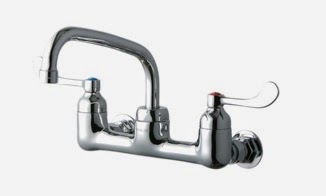Many bathroom and kitchen faucets are built to last, but
nothing can last forever. Many times
when there is a problem with a faucet-if it is leaking or some part of it is
broken-it can usually be fixed with some sort of replacement part. There are washers, o-rings, screws, and many
other small parts that can be replaced to fix a broken faucet. These parts are most commonly used to fix
faucets that are leaking-whether it be a handle or the faucet spout. Sometimes the problem may be something that
is a little bigger-such as the handle itself, the faucet spout, or a sprayer
unit. When looking for a solution to the
problem, you may have to take the faucet apart in order to know what needs to
be replaced.
Taking apart a faucet can be a challenge, depending on
what type of fixture you are dealing with.
When you are taking the faucet apart, it is important to make sure you
are doing so in an organized manner.
Some handles, spouts, and sprayer assemblies will have a number of small
parts inside of them-like washers, o-rings, etc. When you are taking apart these different
parts, the small parts may fall out-making it difficult for you to know where
each part fits. If possible, find out
the brand and model of faucet that you have.
If you are able to find out what faucet you have, you can go in the
internet to the manufacturer’s website.
Most of these sites have a resource called the “exploded parts view”
document that will show you each part of the faucet and where it fits. Many of these also have the model numbers of
the different parts so that you can find the replacement part that you need.
A common problem with faucets is that the o-rings or
washers will become worn and their ability to create a seal will fail. This will result in a leak in the part of the
faucet where they are installed (whether it be the spout, sprayer, or
handle). Other times, screws will become
rusty which can make them brittle and as they are being tightened or loosened
they can snap in half. Other things can
happen (such as kinds messing around in the bathroom where they shouldn’t be
playing at all) and the handle or other part of the faucet will break. There are many replacement handles that can
be purchased to fix these problems as well.
Buying a replacement part will save you money, especially if you are
buying a small washer as compared to purchasing a new faucet entirely.
There are many other parts to faucets that I haven’t
mentioned that can be replaced. Finding
out which part is causing the problem is half the battle. Once you have determined the cause of the
problem, it should be fairly easy to find a replacement part (if your faucet
isn’t extremely old). Once you have the
parts, you should be able to get your faucet fixed and running in no time! If you already know what part you need, find
it here.









